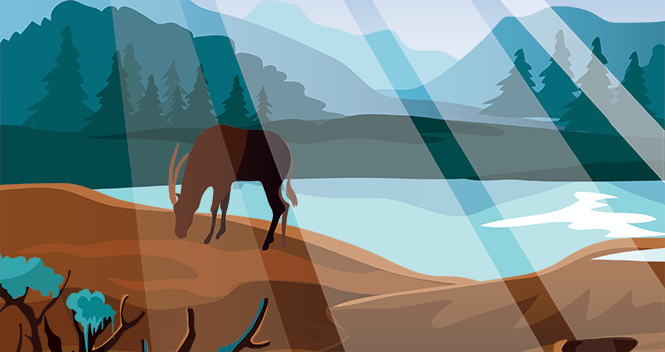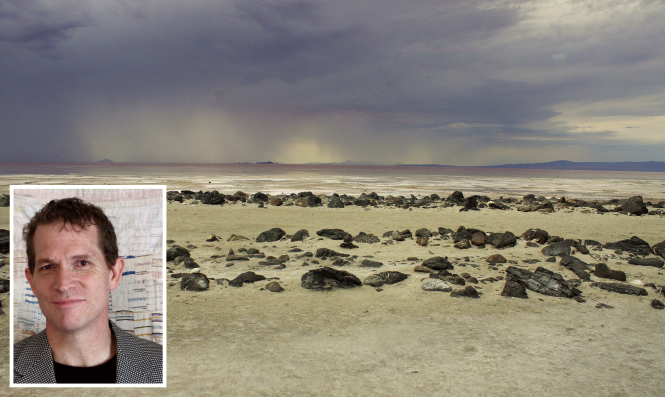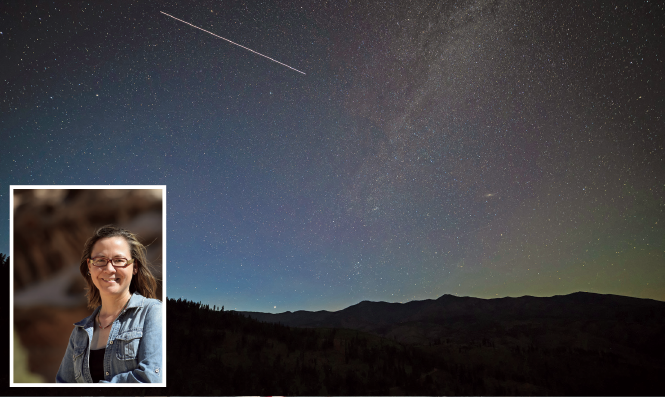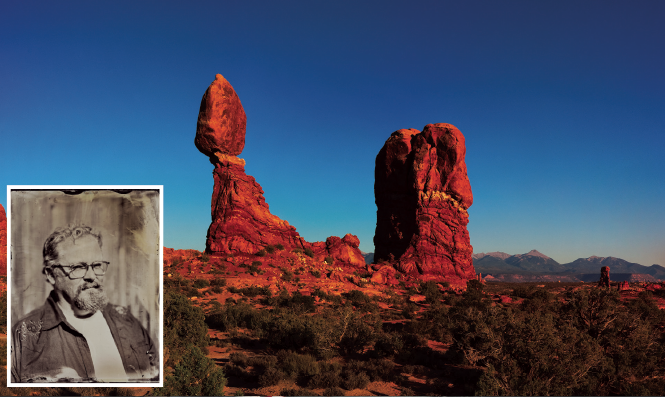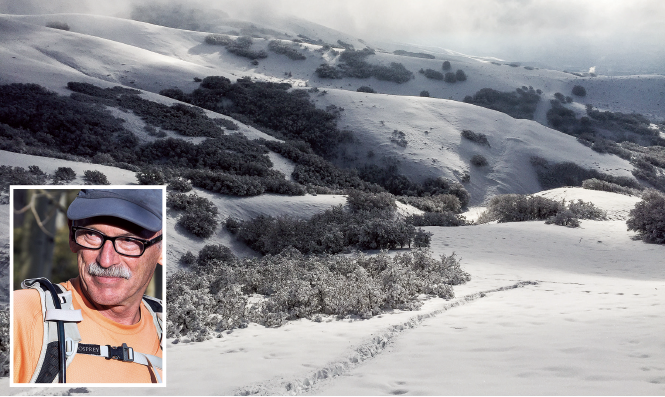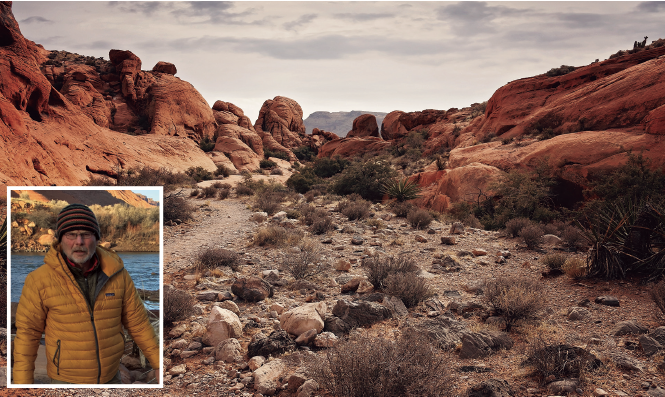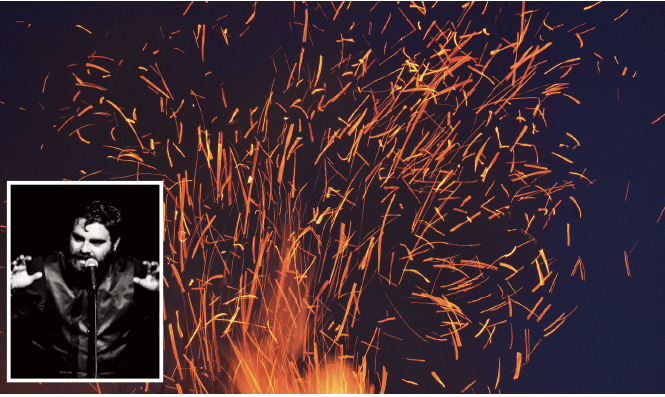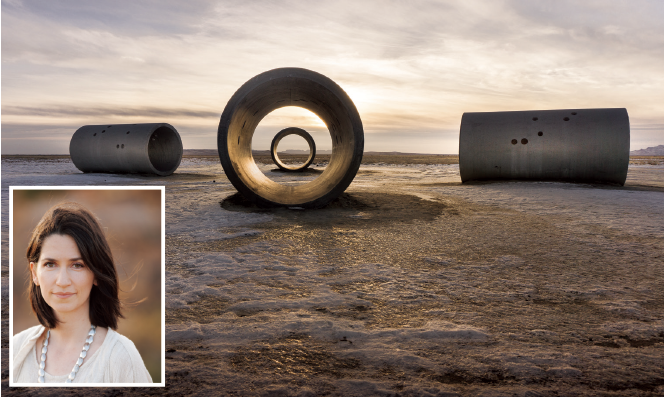Outer Wilderness
Zion-born poems and prose collected for the state's 125th anniversary—Part 2
Utah@125
The choice to be lost in the surprises of this place.
By Ellen Fagg Weist , Utah @ 125 editor
One-hundred twenty-five words is what I asked for. Exactly 125 words. 125 words to represent views of contemporary Utah, all the love and conflict and nuance sparked by the contradictions of this place.
You don't mean 125 words exactly, one brilliant poet asked. Well, yes, I said. Yes, I do. One word representing each year of the state's official history.
Have you ever tried saying anything complicated in 125 words? As writers and editors know, hitting word count square-on is hard. It's editing and re-editing and re-editing. It's trading long beautiful phrases for more compressed beautiful words. It's hard to tell which version works. It's honing in one bit of narrative, one moment, and focusing on the details until you unearth the bigger point embedded in it.
Whatever you call it—flash nonfiction, a short essay, or a prose poem—hopefully the compression, the white space within a 125-word frame, the beauty of what isn't said, offers something textured and interesting for readers.
Diaries. Journalism. History books. Novels. Poetry collections. Volumes upon volumes have been written about Utah and all the intriguing contradictions of this place.
Now with Utah@125, as part of the larger statehood history of Thrive125, we hope these 125-word shorts, written by 22 writers from all over the state, will add up to another kind of Utah story. Eventually maybe we'll add more chapters filled with these compressed views. Eventually, maybe this project will grow into as many as 125 essays. Whatever it becomes, we hope this collection will help reveal more of Utah's 125-year history as it is unfolding in the right now.
Maybe that's too many words. Maybe all these literary flashes need is a 125-word introduction.
There are stories buried in the dust, poets say. Especially in a desert like Utah.
Here, we've compiled true stories by Utah writers, each 125 words long, one word to represent each year of official state history, all the words layered together as part of an ongoing conversation about Who We Are and Why We're Here. Maybe that's what literary stories do best: Remind us that no matter where you came from, or what language you spoke when you arrived, being here is a choice to be lost in the surprises of this place. Utah at 125.
Taylor Fang: On writing down 'all the shiny bits'
Taylor Fang is a 2020 graduate of Logan High School and is now on her gap year before attending Harvard University. Her writing, poetry, and journalism pieces have appeared (or are forthcoming) in a variety of international online publications and platforms, covering topics that she deeply cares about, including feminism, societal oppression, racism and representation.
What it's like to receive the nation's highest honor for youth poets: the 2019-20 National Student Poet of the West?
Taylor Fang: I started writing poetry in middle school because I was really curious about the form. I continued writing because I fell in love with the challenge of telling a story in just a few lines. Poetry gives me a lot of freedom to articulate how I feel and explore the world through rhythms, sounds and textures. In high school, I entered the Scholastic Art and Writing Competition and ended up receiving a gold medal and was invited to apply for the National Student Poets Program (NSPP). Being an NSP has been an incredible opportunity to share my love for poetry with more students from all different types of backgrounds.
Do your peers take poetry seriously?
I get "poetry is weird" a lot. In English class, a lot of people complain when we analyze poems. I think there's just a gap in the way poetry is taught and understood. There aren't a lot of contemporary poets in classrooms, and there's the idea that poems have a "fixed meaning." But I'm optimistic about sharing poetry with more young people through technology, whether slam poetry on YouTube or poems on Instagram. And Amanda Gorman being the inaugural poet was incredible.
Where do you see yourself going with poetry?
There's a famous quote about every poem being unfinished. I love how poetry has taught me that there isn't a destination (cliché as it sounds). I've been thinking a lot about cycles of returning. Poetry will always be a haven and space to return to at different periods of my life, no matter what I'm exploring and learning at the moment.
What poets have inspired you and currently inspire you?
So many. Tracy K. Smith, Jenny Xie, Layli Long Soldier, May Swenson and Molly Brodak are a few of my current favorites.
How do you approach writing a poem?
I always start with a line, image, or memory from my journal. I have a journal where I write down all the shiny bits that interest me. I try to write my poems in bursts, and then spend most of my time revising and editing and cutting what doesn't fit.
How do you know a good poem when you hear one?
There aren't fixed metrics for a "good poem." Personally, I look for two main parts: attention to language and a deep emotional thread. I love poems with musicality and lyricism, and poems that play with language in surprising ways. I also want to feel the emotional weight of the poem and resonate with it. Those are the poems that stick with me.
How will you be celebrating National Poetry Month?
I'll be working on an app I created to share poetry and combine it with music, art, links and video (it's called Inlet, and the website is at inlet.space.) And I'll definitely be reading lots of poetry!
—by Jerre Wroble
Nesting
By Taylor Fang
In autumn, my mother and I look up to the sky and search for birds. In Chinese
culture, magpies symbolize good luck. I can imagine my mother on her first
day in Utah, craning her neck to follow arcs of flight. I like to imagine she saw
magpies that first day: a parliament of birds lopping off the sky, sleek bodies
spearing the clouds. But maybe she saw crows, a bad omen.
After all, our then-nearly-100-year-old neighbor, Maxine, fed potatoes to crows in her backyard. Maybe
crows weren't so bad, since we loved Maxine. We called her my mom's "American mother." So now, when I
step outside, I look for magpies and crows both, their wings dappled against a grey Utah sky.
Taylor Fang, a Logan High School graduate, was the 2019-20 National Student Poet of the West. She has been published in The New York Times and will attend Harvard University next year. taylorfang.weebly.com
Looking for Spiral Jetty
By Lance Larsen
Standing at the tip of Spiral Jetty, surrounded by pink briny Great Salt Lake, I was tempted to draw conclusions. But none came. Instead I settled for comparisons. Spiral Jetty was like Crick and Watson's double helix. Like Yeats' falcon, turning and turning in a widening gyre. Like Hitchcock's Vertigo. Like the whiteout my father experienced in an Idaho snowstorm, so disoriented he pulled over and closed his eyes to prove he wasn't in motion. You can find Spiral Jetty in art history books, but until you've walked all over it, water sloshing your ankles, you can't know its mesmerizing strangeness. Dickinson once said, "We both believe, and disbelieve a hundred times an Hour, which keeps Believing nimble." I was moving. I was standing still.
Lance Larsen, a former Utah poet laureate, is the author of five poetry collections, including What the Body Knows. His work was selected for Best American Poetry 2009. He teaches at Brigham Young University.
Whence and Wherefore
By Patrick Madden
Not in the vast mirror of clear sky in the Great Salt Lake. Not in the caked salty crust of the receded ancient sea. Not in the towering solidified orange blobs of hoodoos. Not in the steadfast delicate arches. Not in the crisp blanket of frozen white over crags and crevices. Not in the vast underearthed connections of roots and shoots breaking out reaching for orbit, but perhaps something like it: a Halloween afternoon, sun bright and warming, and hundreds of people patrolling our neighborhood calling out the names of my sons, aged one and three, gone missing, seriously missing, as the firetrucks blare their sirens and neighbors and officers all focus on my family's dire need to find our boys. Which we did. Together.
Patrick Madden is the author of the essay collections Disparates, Sublime Physick and Quotidiana. He has taught at Brigham Young University and lived in Utah since 2004. quotidiana.org
Dark Sky as Verb
By Erica Soon Olsen
In or around March 2020, the night sky changed. A neighbor in the canyon called reporting strange lights passing over our house. UFOs! They streamed across the sky, one after another. I'd waited all my life to see something like that. Later, we found out what it was: a Starlink satellite constellation, in low-earth orbit, launched by SpaceX for internet access.
This is northeast Utah, near two dark sky parks. Like other parks, these call attention to something special—a history, a wilderness—in a way that could make you grieve the loss of things in other places. Museum skies. What we dark sky now is our responsibility. Moths, the Milky Way, the Pleiades' bright smear. Smoke from the East Fork fire, smoke from Oregon.
Erica Soon Olsen is the author of two fiction collections, Recapture & Other Stories, about the once and future West, and Girlmine, about the uneasy ways we live in the natural world. She lives in Vernal.
Metamorphosists
By Todd Robert Petersen
I am a child of the rainforest, raised among emerald mosses and fern and the decay of nurse logs, hosts of the next generation. My children live among twisted sage and juniper and the red rock eons exposed in road cuts and slot canyons. They know an absolute clarity of blue sky still new to me after twenty years. I have followed the coil of the spiral jetty, shared a sweat lodge with a Paiute park ranger, polygamists, and drifters. I have prayed in pews alongside addicts, widows, cancer survivors and grifters, people who have lost their faith but found their way. There are unexpected temples and shifting congregations, like the colors of stone as the sun passes over us and sinks in the West.
Todd Robert Petersen is the author of four works of fiction, the most recent of which is Picnic in the Ruins. He is a professor of English at Southern Utah University, where he teaches creative writing and film studies.
Do You Know Me?
By Willy Palomo
When Dillon Taylor lay outside 7-11 on an August night, I was the song spilling out of his headphones. Before his family could afford a drum, I was the broomstick a Paiute boy beat against his bed. I hang around Dr. Kristen Ries's neck and am pressed against chests, frail but relentless. Once I was Mexico. Sometimes I still am. I am the silence in the bishop's office, a prayer that lost its way but never lost its faith. I was not a father to Wallace Thurman, but the paper cut beneath his pen. Before you mispronounced my name, I was already sand. When Brigham Young said This is the Place, I was already here.
Willy Palomo is the queer son of two immigrants from El Salvador. He is program manager for Utah Humanities' Center for the Book. palomopoemas.com
Horeb, Utah
By Tim Slover
There are no houses on this stretch of road. There is instead a wide field of grasses sun-bleached to gold most of the year. Beyond the field are sage-green, rounded humps of foothills. And then the mountains rise suddenly like shouts of granite, the outlines of their peaks cut out against the Klein Blue sky. When I walk there before autumn dawn, dazzling Venus leaps into the sky above them while Mars burns rust-red over the valley and Sirius beckons between, and I feel I'm walking through the whole universe. In a thin copse of lacebark elm is a rock that could have been purpose-built for musing. Sometimes I sit on it, and then the landscape lights up with Spirit.
Tim Slover heads the University of Utah Department of Theatre's playwriting program and co-directs the London Learning Abroad program and other England-based programs. His plays include Joyful Noise, Treasure and The Two Noble Kinsmen.
Shoreline Trail, Solstice
By Stephen Trimble
Winter solstice, the end and the beginning. I walk the Shoreline Trail at sunset—to an easily reached knoll with a commanding view. This perch on the trail, where desert and mountains have equal weight, seems perfect to witness the year's passing.
The sun drops westward, an orange ball over blue distance, closer and closer to the Great Salt Lake and its islands and the Great Basin mountain ranges beyond. At my feet, the valley sweeps away in snow-covered white. Alpenglow flushes the peaks of the Wasatch. The sun touches the horizon—out toward Nevada—then slips away.
I luxuriate in the moment, the place and the passage that mark our lives with beauty and grace and tie us to the rollicking cycles of Earth.
Stephen Trimble, a writer and photographer, has published 25 books, including The Capitol Reef Reader, while paying attention to the Desert West. Trimble lives in Salt Lake City and Torrey. stephentrimble.net
My Utah Jacket
By Brooke Williams
This wasn't just any parka, but a Patagonia Fitz Roy down (made from Traceable Down: 800-fill-power goose down) parka. According to the catalogue it was designed for serious alpine climbers—to wear during extended freezing belays or high-altitude emergency bivouacs.
Anything but a serious alpine climber, I am a committed wilderness explorer. Lately the wilderness I explore is vastly internal. I get there through the "outer wilderness"— in Southern Utah during a solitary walk in a familiar canyon, or looking up through the universe on a moonless, often cold, desert night. Or sitting in a camp chair in the winter desert awed watching cliff light pass through the entire spectrum of red, as the sun sets.
My parka is perfect for this, too.
Brooke Williams has spent 30 years advocating for wilderness. He has published four books, including Open Midnight and Halflives: Reconciling Work and Wildness. He and his wife, Terry Tempest Williams, live near Moab.
A Fire in Sugarhouse Park
By RJ Walker
In 1903,
Sugar House Park
was a prison.
This prison sold tickets
to executions by firing squad.
When you fall in love at this park,
you feel it between the eyes.
You feel that gunpowder boom
in your chest as if it were your own heart
tied up and convicted.
Your shoulder aches
where the gun
suckerpunched the rifleman
and you hold on to your love so tightly
that it escapes like a ghost.
You know,
this park was known for its fireworks.
The loud and colorful bursting
of gunpowder.
Then, in 2017
the fireworks set the park ablaze.
I watched the fire from my car.
And something criminal inside of me
burned away.
RJ Walker is a performance poet and voice actor. He has performed at the national poetry slam numerous times, and hosts The Greenhouse Effect Open Mic, Salt Lake City's longest-running open-mic event.
Sun Tunnels || 41.3035 ° N, 113.8638 ° W
By Kathryn Knight Sonntag
I step inside. One, then another, four cylinders of concrete sky. I step inside the spinning cosmos. Star-holes glow above, forming constellations:Draco, Perseus, Columbia and Capricornus.
I emerge and stand on a circular concrete pad, marking the convergence of solar lines. Here I am made aperture, lens. The axis mundi made flesh.
To the east: Desert Peak, stained pink.
To the west: the winter sun, sliding into sky, circumscribed.
Brought into frame, streams of amber light bathe my eyes, pour down my body, back out into the land, speak of the ways the heavens make sense of Earth. Of exactly where I stand in the desert's expanse.
Of how I might grasp immeasurable creation, the wilderness—my home—on the day of shortest light.
Kathryn Knight Sonntag holds a master's of landscape architecture and environmental planning and works as a land planner in Salt Lake City. Her debut poetry collection, The Tree at the Center, was published in 2019.
Cardinal Alignment
By Lehua Parker
Once again, I'm lost in Provo.
They said, "Go south one block, then turn east. Entrance faces north."
Growing up Hawaiian, Utah's as foreign as Mars. North? East? Only tourists navigate this way.
Here I'm perpetually adrift, wandering the desert like Moses.
Utahns say look at the sun.
But it's night.
My pioneer ancestors collectively face-palm. Utah's an ancestral home, but my roots feel too thin.
Suddenly, there's warm Waikiki sand under my feet. My Hawaiian kupuna, navigators who
easily crisscrossed the vast Pacific, raise my chin toward Utah Lake and whisper,
"Think makai." Toward the ocean.
Timpanogos. "Mauka," they say. Toward the mountains.
Left. "Diamond Head. Payson. South."
Right. "'Ewa. Salt Lake. North."
Aligned to land, not sky, I'm grounded.
And never lost again.
Lehua Parker writes speculative fiction for kids and adults, often set in her native Hawaii. She is also an educator trained in literary criticism who advocates for indigenous cultural narratives. LehuaParker.com
This Far Country
By Connell O'Donovan
I have perched precariously atop slickrock fins and seen such
Beauty in this far country.
I embrace it with my skin, my blood
And in return the desert does not forget my sweat.
But she also calls out to me, "Your heresy here runs as thick as honey across my sands."
I have choreographed my way through aspen groves here that are older than god,
chanting memories and whispering love spells to this land.
And in return the forest clings to my arms like some wild, parting lover but reminds me
that I have no welcome among this people.
My queerness is too colorful, too sad,
too deep, too decadent for those trapped here by
the patriarchal grip of our state motto:
Fecundity, Mediocrity, Hypocrisy.
Connell O'Donovan is a historian, biographer and genealogist, working on a history of female impersonators in Utah, and a documentary on 1926 double suicide of two young Mormon lesbians in Salt Lake City.
Editors’ note:
This is Part II of the Utah@125 chapbook published online at thrive125.utah.gov. Special thanks to Josh Loftin, Utah Department of Heritage & Arts PIO, for his help in publishing this feature.
Latest in Cover Story
Readers also liked…
-
Forget the family pedigree—Robert F. Kennedy Jr should not be the next president of the United States
Trojan Horse
- Jun 21, 2023
-
Women decry harassment and toxic culture at St. George auto dealership
Men at Work
- Oct 11, 2023


